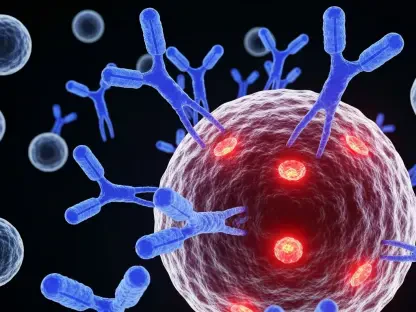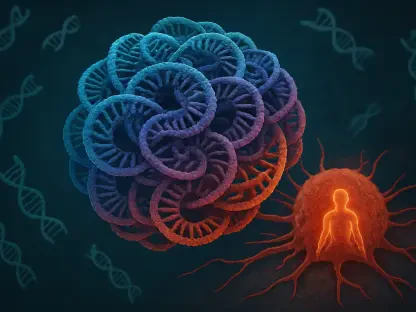The world of ophthalmology faces a promising yet complex challenge as it navigates the treatment of age-related macular degeneration (AMD), a leading cause of vision loss across the globe. In recent years, advancements in medical research have unveiled new pathways to tackle this degenerative condition, which affects the central portion of the retina, impairing sharp and detailed vision. Among these advancements is GAL-101, an eyedrop under investigation by Galimedix Therapeutics. GAL-101 aims to counter the progression of AMD and potentially treat other neurodegenerative diseases by targeting specific molecular processes. As efforts intensify to examine this novel therapy’s potential, understanding its implications in the broader AMD treatment landscape becomes pivotal.
Understanding AMD: A Multifactorial Challenge
The Nature of AMD
AMD is inherently multifactorial, affecting millions worldwide, and its incidence escalates with age, particularly among individuals aged 50 and above. This condition initiates subtly with the accumulation of drusen—yellow deposits under the retina. While drusen themselves are not directly sight-threatening, they are indicators of the disease’s progression, which can evolve into one of two primary forms. The first form, known as “wet” AMD, is marked by abnormal blood vessel growth beneath the retina, potentially leading to rapid vision loss without treatment. The second form, “dry” AMD, can result in geographic atrophy (GA), where retinal cells and tissues progressively deteriorate, culminating in severe vision impairment.
The Risks and Impact Factors
While smoking and poor dietary habits have been linked to increased risks of developing AMD, genetic predisposition also plays a significant role in the condition’s manifestation. The complexity of AMD is further accentuated by its unpredictable development and progression, posing substantial challenges for effective management and treatment. Beyond mere statistical prevalence, AMD represents a profound impediment to quality of life, resulting in practical difficulties with daily tasks and increased reliance on assistive technologies. These ramifications reinforce the urgency for innovative treatments capable of attenuating or halting the disease’s advancement, thereby preserving vision and independence for affected individuals.
Current AMD Treatment Strategies
Addressing “Wet” AMD
Historically, treatment efforts have primarily focused on managing “wet” AMD to curb abnormal blood vessel growth swiftly to protect vision. Since 2004, one of the cornerstone therapies involves the use of anti-vascular endothelial growth factor (anti-VEGF) injections. These drugs work by inhibiting the signals that trigger the development of new, fragile blood vessels beneath the retina, a process that characterizes wet AMD. The success of anti-VEGF treatments in substantially slowing progression and preserving vision for countless patients represents a notable advancement in AMD management. However, this therapeutic approach does not address the underlying causes of AMD or provide a solution for managing “dry” AMD effectively.
Navigating Challenges with “Dry” AMD
Conversely, “dry” AMD presents a more nuanced challenge, as it involves progressive retinal tissue decay without the formation of new blood vessels. While the FDA has recently approved drugs that target the complement pathway—an integral part of the immune system—inflammation management has yet to produce significant improvements in visual acuity for individuals suffering from “dry” AMD. Consequently, many patients face a substantial unmet need for efficient interventions, highlighting a gap in therapeutic strategies where innovative solutions could be groundbreaking. The pressing need for advanced treatments in this arena underscores the relevance of novel approaches like GAL-101, which seek to intervene at different molecular stages in the disease process.
Galimedix Therapeutics: A Novel Approach
Innovation in Beta-Amyloid Therapy
Galimedix Therapeutics is pioneering a groundbreaking approach by targeting beta-amyloid, a pivotal protein implicated in both AMD and Alzheimer’s disease due to its presence in drusen deposits. Beta-amyloid is notorious for its tendency to misfold, leading to toxic oligomer formation, which is instrumental in neuronal and retinal damage. GAL-101, designed as an eyedrop therapy, seeks to inhibit the formation of beta-amyloid 42 oligomers, thus preventing their toxic action. Unlike other anti-beta-amyloid therapies that have typically focused on inert forms like plaques, GAL-101 targets the early-stage oligomerization process, aiming to provide more effective neuroprotection by curbing damage before it can propagate.
Conception and Expectations
By intervening early in the oligomer formation process, GAL-101 endeavors to preserve retinal health and delay AMD progression effectively. The proactive approach bolsters hopes for potentially greater neuroprotective outcomes across diverse patient profiles and stages of disease manifestation. The conception of GAL-101 embodies a shift toward preventative strategies that mitigate the onset of retinal and neuronal damage, addressing specific molecular mechanisms that drive chronic retinal conditions. Its success relies on clinical validation, which determines its capacity to deliver meaningful enhancements in visual outcomes for AMD patients and, by extension, those manifesting similar neurodegenerative symptoms.
GAL-101 in Clinical Trials
Exploring GA Lesion Development
The intricate pathophysiology of GA calls for an innovative examination, prompting Galimedix to initiate a Phase 2 clinical trial to explore GAL-101’s effectiveness. This trial concentrates on patients exhibiting small GA lesions, positing that early intervention could decelerate or potentially forestall progression to more severe retinal damage. The hypothesis underscores prevention of toxic oligomer formation rather than simply mitigating existing aggregations, aligning with the principle of strategic early-stage molecular intervention. For GAL-101, the phase trials represent a crucial step in demonstrating its therapeutic potential within AMD’s overall treatment framework.
Anticipated Outcomes
While clinical trial results remain forthcoming, expectations are high that GAL-101 could reshape AMD treatment approaches, as confirmation of its efficacy would indicate a substantive alternative to current practices. The focus on deterring toxic processes at their onset captures pioneering scientific efforts to unravel AMD’s complexities, envisioning proactive rather than reactive care paradigms. This change promises repercussions not limited to AMD alone, as neurodegenerative disorders sharing similar protein misfolding pathways—and potentially vulnerable to beta-amyloid oligomers—stand to benefit from research and therapeutic developments guided by GAL-101’s outcomes.
Broader Implications Beyond AMD
From Retinal Diseases to Neurodegeneration
The significance of GAL-101 transcends conventional AMD therapy, with profound implications for other neurodegenerative diseases. With its ocular administration successfully addressing AMD pathology, researchers speculate broader applications for GAL-101, such as adapting it for systemic neurodegenerative conditions like Alzheimer’s disease. Trials assessing its oral form are underway, illustrating the potential of leveraging shared pathogenic pathways among diverse conditions for therapeutic innovation. The research embodies the cross-pollination of insights as scientists endeavor to introduce novel solutions to a wealth of neurological challenges.
Embracing Personalized Medicine
One of the prominent trends accompanying the development of treatments like GAL-101 is the evolution toward personalized medicine. Investigators increasingly recognize that genetic predispositions, lifestyle choices, and environmental exposure shape disease manifestation and progression uniquely. By identifying these factors and designing individualized treatment frameworks, researchers can optimize therapeutic outcomes, reducing treatment resistance and enhancing patient engagement. Personalized medicine underscores GAL-101’s role within a broader movement to advance precise, holistic treatment paradigms, offering remedies tailored to intricate biological pathways and individualized needs.
Path Forward and Research Implications
Seeking Clinical Validation
Research focusing on interrupting key molecular mechanisms embodies a promising direction that necessitates rigorous clinical validation. Although GAL-101 has embarked on a speculative journey with tremendous potential, translating its laboratory success to practical clinical efficacy remains critical. Detailed assessment of GAL-101’s performance in trials will clarify its contribution to combating chronic retinal and neurodegenerative conditions, determining its acceptance as a viable mainstream therapy. Pursuing collaborative endeavors that integrate multidisciplinary expertise and innovative scientific tools ensures that the research imperative continues to flourish.
Fostering Collaborative Innovation
This research domain demands collaboration across disciplines and sectors, encouraging exchange between neurologists, ophthalmologists, pharmacologists, and geneticists, among others. Successful development and application of GAL-101 signal the need for shared insights and cooperative capacity-building efforts that bring diverse resources together. Engaging in collaborative innovation bolsters the field’s momentum as it embraces novel questions and solutions, culminating in sustainable therapeutic strategies that benefit patients worldwide. Confirming GAL-101’s efficacy could catalyze broader advances across retinal and neurodegenerative disease management.
Conclusion
The field of ophthalmology is confronting an exciting yet daunting task as it works on treating age-related macular degeneration (AMD), a predominant cause of vision loss globally. This degenerative eye condition primarily affects the retina’s central area, leading to impaired sharpness and clarity of vision. Recent advancements in medical research have paved the way for innovative approaches to combat AMD. Among these new developments is GAL-101, a novel eyedrop under exploration by Galimedix Therapeutics. GAL-101 is designed to halt the progression of AMD and possibly address other neurodegenerative diseases by targeting distinct molecular pathways. As research into this groundbreaking treatment continues, it becomes crucial to assess its wider implications within the AMD therapeutic landscape. With significant potential on the horizon, GAL-101 represents a hopeful step forward in preserving vision and improving the quality of life for those affected by AMD. As the scientific community focuses on the efficacy and safety of GAL-101, understanding its role in the broader context of AMD treatment is essential. This reflects the ongoing commitment to finding effective solutions for a condition that significantly impacts individuals worldwide.









